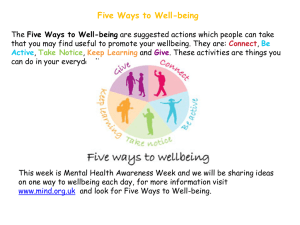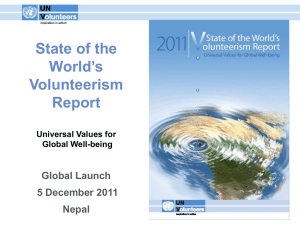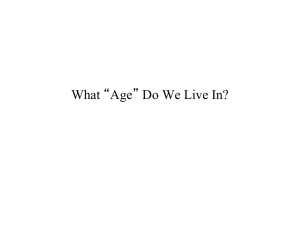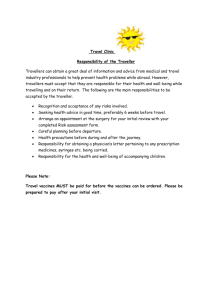seminar on measuring children`s and young people`s well
advertisement
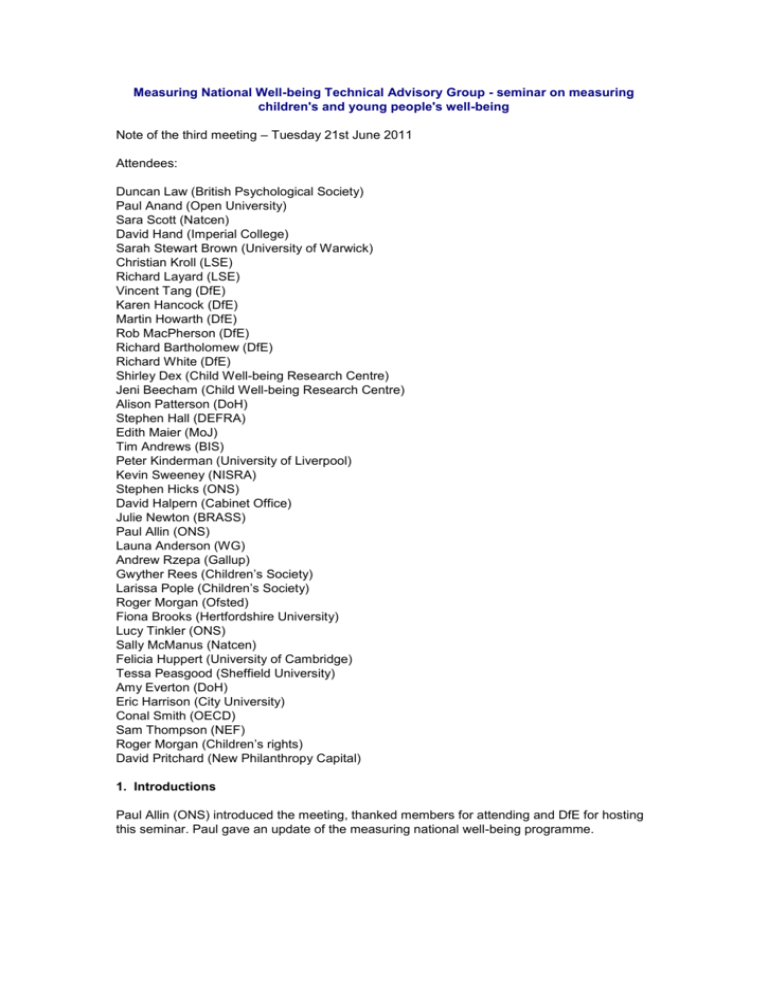
Measuring National Well-being Technical Advisory Group - seminar on measuring children's and young people's well-being Note of the third meeting – Tuesday 21st June 2011 Attendees: Duncan Law (British Psychological Society) Paul Anand (Open University) Sara Scott (Natcen) David Hand (Imperial College) Sarah Stewart Brown (University of Warwick) Christian Kroll (LSE) Richard Layard (LSE) Vincent Tang (DfE) Karen Hancock (DfE) Martin Howarth (DfE) Rob MacPherson (DfE) Richard Bartholomew (DfE) Richard White (DfE) Shirley Dex (Child Well-being Research Centre) Jeni Beecham (Child Well-being Research Centre) Alison Patterson (DoH) Stephen Hall (DEFRA) Edith Maier (MoJ) Tim Andrews (BIS) Peter Kinderman (University of Liverpool) Kevin Sweeney (NISRA) Stephen Hicks (ONS) David Halpern (Cabinet Office) Julie Newton (BRASS) Paul Allin (ONS) Launa Anderson (WG) Andrew Rzepa (Gallup) Gwyther Rees (Children’s Society) Larissa Pople (Children’s Society) Roger Morgan (Ofsted) Fiona Brooks (Hertfordshire University) Lucy Tinkler (ONS) Sally McManus (Natcen) Felicia Huppert (University of Cambridge) Tessa Peasgood (Sheffield University) Amy Everton (DoH) Eric Harrison (City University) Conal Smith (OECD) Sam Thompson (NEF) Roger Morgan (Children’s rights) David Pritchard (New Philanthropy Capital) 1. Introductions Paul Allin (ONS) introduced the meeting, thanked members for attending and DfE for hosting this seminar. Paul gave an update of the measuring national well-being programme. 2. How to include the well-being of children and young people in wider measures of national well-being, including in the measures of subjective well-being? Stephen Hicks (ONS) gave a brief overview of children's well-being and the importance of capturing children's and young people's well-being in terms of measuring overall national wellbeing. The importance of children’s and young people’s well-being came through strongly in the national debate. There is a need for comparison over time, and across countries. It is important to consider policy needs when considering measurement. Stephen recognised that there is already a lot of research into children and young people’s well-being. However, there are limitations of the data already available such as the lack of trend information over time, (for example, the British Household Panel Survey only dates back from 1994) less is known about the differences in sub-groups of children, e.g. hard to reach groups and estimates are generally available for older children. Stephen proposed that there is a need to have agreement on the dimensions of well-being that are important for young people and consensus around what age bands should be included. Stephen also added that one of the criticisms that have been made is that more attention is given to negative aspects of children's well-being than to positive aspects. Stephen highlighted the following questions for the later discussion: 1. How best can we collect children and young people’s subjective well-being (SWB) data? 2. What research is already being carried out and could be drawn on? 3. Can we harmonise? 4. How do we ensure children and young people are consulted about the measurement of their well-being? Sarah Stewart-Brown (Warwick) commented that the 'every child matters' initiative had generated relevant research on measuring children’s and young people’s subjective wellbeing. 3. Overview of existing work: Jeni Beecham and Shirley Dex (Child Well-being Research Centre) gave an overview of the work of the Child Well-being Research Centre with the Institute of Education and Childhood Well-being. Focusing on subjective well-being a partnership group was formed with the Universities of Loughborough and Kent. Work has been carried out on range of well-being outcomes using available data (objective measures of well-being) and analysis of these measures has been carried out. Well-being is measured at three levels, universal (life satisfaction), domain measures (different event aspects of life), and targeted measures (those which focus on particular group's such as vulnerable children). The work also included a review of 'state of play' measures. Jeni raised concerns over the current quality of SWB measures for children and whether they were fit for use in policy. Quite a lot of work is needed before developing questions for measuring SWB for children. Jeni Beecham talked about the development work that the centre carried out, looking at measures of SWB as influenced by services that children use. Richard White (DfE) spoke about the DfE research programme and stressed the importance of support from policy colleagues to measuring well-being and working with ONS and other stakeholders. The DfE carried out an in-house review of existing work on children and young people’s subjective well-being measures. As a result, a decision was taken to include the ONS overall subjective questions on the National Citizen's Service Evaluation Baseline Survey. The survey collects information on smoking, drinking, drug-use, and self-esteem; most respondents would be 16 and the survey is self completion rather than interviewer administered. Richard explained how it will be a challenge is to obtain survey data from the 11-15 age group, although SWB questions have been tested on respondents of this age group. Richard asked the group for comments on this issue. Fiona Brooks (Hertfordshire University) spoke about the WHO study of health behaviour in school aged children that the use of the Cantril ladder question and other pictorial questions work well with children. Research has been carried out into this issue through focus groups carried out with 7-8 year olds, and the Cantril ladder question was found to work well. This finding was supported by Andrew Rzepa (Gallup). Gwyther Rees gave an overview of the Children’s Societies' work in this area. Gwyther explained that the Children's Society has been involved in research into children subjective well-being since 1995 in conjunction with the University of York. Part of the remit of this work was to include children's voices into the research. In 2005 research was carried out using open ended questions asking children their ideas on well-being. This work gave an overall grounding in key aspects of well-being and was followed up with a 2008 a survey of 8000 young people. This was taken forward into a survey in 2010 which aimed to aid understanding of the variation in children's well-being. The 2008 questions proved to be statistically robust and were published in an index. Five questions were asked on life satisfaction; the other 10 questions used a 0-10 scale and ask about different aspects of life. The same domains were used in the same order over four waves. The Children’s Society worked internationally with UNICEF to develop a standard international survey, cognitive testing was used to test for international sensitivity of the questions. In total, 25,000 children and young people from age 10 onwards were included in the sample. The questions were found to work well although the ‘agree/disagree’ questions tend to work less well with 8-9 year olds, however, from 10 years onwards these questions were found to be very statistically robust. Gwyther outlined how there is interesting work to be carried out in terms of uncovering sub-groups that are faring less well, e.g. disabled children and the effects of household income on well-being. The next planned survey will include positive and negative affect questions and those on psychological well-being. Roger Morgan (Children’s Rights) explained that he worked in a small team hosted by Ofsted which has the statutory function in relation to vulnerable children e.g. children in care along with all other children who live away from home. As part of this work a number of well-being questions have been administered particularly in terms of domain area, e.g. what are the good and bad things about certain aspects of life? An exercise is also being carried out annually regarding surveying children's social care in England, including well-being questions on aspects of care and bullying/absence of bullying. A consultation programme has been put in place with the theme of well-being /happiness. Focus groups may be included in order to develop questions and scales of measurement. There is also a mobile phone text survey. The results from this showed that 'friends and family' rank very highly, concepts of stability and security, and concept of personality were also seen as important, though the research is fairly small scale. Andrew Rzepa (Gallup) gave an overview of the Gallup world poll of global well-being which has taken place since 2006, Andrew explained how a sample of national well-being in US, UK and Germany is carried out in addition to the world poll. Gallup have developed a list of 20 well-being indicators regarding well-being in student’s education, (12 – 17 year olds). The results help distinguish between high and low performing schools and students. David Pritchard (New Philanthropy Capital) explained how in helping charities track 'soft' outcomes the New Philanthropy Capital developed a survey tool which had eight different components. Although the tool has research limitations, (it is self selection of which aspect want to answer questions about) it can be used as a practical measure for organisations which don't have their own research and monitoring applications. Fiona brooks (Hertfordshire University) gave an overview of the ‘health behaviour in school aged children study’. The survey was initiated in 1982 and is administered in 43 countries in Europe and North America including England, Wales, and Scotland. The survey is conducted every 4 years and trends analysis, additionally cross-national analysis can be carried out on the dataset. Age related analysis has been carried out on the 11, 13 and 15 age groups. The survey includes measures on physical, emotional, social health and well-being, as well as behaviours that risk and promote health and places behaviour in children in social context. Additionally the survey looks at tobacco, alcohol and drugs, physical activity, consumption of food and drink, tooth brushing, weight control, fighting and bullying, sexual behaviour, TV and computer use, electronic communication, self-rated health, life satisfaction, health complaints, body image body mass index, injuries, and more recently happiness has been included. Analysis is carried out by gender and different age groups. There are also family affluence questions including family car ownership, having own bedroom, number of family holidays, and number of family computers. 4. Round table discussion regarding overall comments and action planning Comments were received around the topics of question design and measurement, location of potential surveys, collecting data from young children, and, the need to consult with young people in the design of the survey. Questions/Measurement: Tim Andrews (BIS) commented that different SWB questions may be needed at different ages throughout life. Sarah Stewart-Brown (University of Warwick) stressed that it is important not to put on adults feelings when designing questions on children’s well-being and instead try to measure children’s real feelings. Sara Scott (Natcen) raised the importance of language and concepts and how it is hard to harmonise internationally. Richard Layard (LSE) highlighted that the questions asked in the ‘strengths and difficulties’ questionnaire (SDQ) used by Robert Wyman would be a very useful tool. Felicia Huppert said that she was impressed by what is going on in children’s wellbeing arena. Felicia thought it would be a challenge to combine children and adults well-being. So far there has not been a lot of discussion about children's assessment of their own capabilities and resilience and about empathy in the questions tasked about so far and that this should be an important aspect in terms of measurement. Felicia agreed with others that SDQ is primarily about disorder and therefore would not cover all aspects of well-being. Martin Howarth (DfE) stated that it may be difficult to identify the drivers of children’s well-being for use in policy as there are so many aspects. Location of survey: Richard Layard (LSE) raised the issue of where a survey into children's well-being should be carried out. The setting of the survey should be the location where it will have the biggest impact for local government policy makers, therefore the surveys should be based in schools. Richard stated that parents, teachers and children above age 11 should be asked the subjective well-being questions. If every school carried out this exercise it would have the byproduct of helping schools understand their students. The questions would need to be different from the IHS adult questions and questions for the under 11’s would also need to be different. Paul Allin (ONS) asked the group for comments on this, especially around the sensitivities of administering a survey in school: Karen Hancock (DfE) stated how presently the government is trying to reduce data collection in schools and also to let schools decide for themselves what they allow. Any survey work will compete with study time. Karen added that the school environment will affect responses and that this needs exploring. DfE is keen to work with ONS on measuring children’s as well as vulnerable adult’s well-being. Richard Layard (LSE) suggested that there could be an incentive for schools to take part such as access to survey results. Andrew Rzepa (Gallup) added that schools in the US are very receptive to taking part in similar surveys if they can have access to results Fiona Brooks (Hertfordshire University) added that if schools are given scores and a financial incentive it helps build up rapport with schools. Regarding the school environment affecting results Fiona stated that the survey can be carried out in informal exam conditions to help anonymity. Roger Morgan (Children’s rights) stated that children feel it is important for their wellbeing to have their say. It is also important to feed survey data back to children and not just to schools and that children and young people have a high level of suspicion regarding preservation of confidentiality, especially when children know that feedback will be sent back to schools. Roger also drew attention to the fact that children might mention something in the survey that needs to be followed up, this could be in conflict with a policy of confidentiality. Collecting data from young children: Sarah Stewart-Brown (University of Warwick) stressed how young children should be surveyed as research has found that very early parenting is the key. Sarah added that the SDQ focuses on the negative aspects of children’s well-being and therefore does not cover all aspects of children's well-being. Duncan Hall (British Psychological Society) described how attachment is probably one of the biggest aspects of children’s well-being, however, it is difficult to measure. SDQ has been used many times and would be useful to drive policy as it allows you to measure children, parents, and teachers, although there is need for both positive and negative aspects to be measured. Paul Anand (Open University) stated that capabilities in younger children could be measured by for young children using techniques measuring mother's subjective wellbeing. Paul added that he was optimistic about collecting data from young children. Sarah Stewart Brown (University of Warwick) added that it is possible to collect useful data on parent’s relationship with a child at a young age as this has a big impact on their current and future well-being. Consulting with children and young people at the design stage: Julie Newton (BRASS) drew attention to the fact that children and young people’s voices should be involved in commenting over the types of measures designed to assess well-being. This view was supported by Fiona brooks and Roger Morgan. Gwyther Rees (Children’s Society) stated how the Children’s Society has already consulted with children re what they feel is important to well-being. A key theme was the importance of choice, this is often neglected in children’s well-being measures. Sarah Stewart Brown (University of Warwick) stated that this group could consult with children to get their views on what we have discussed/decided. Sarah added how longitudinal data on this topic would be very valuable. Richard Batholomew (DfE) commented how the Children's Society questionnaire does already take account of what children think is important to well-being. Richard stated how the environment in which the survey takes place will have an effect on the answers children give to the questions. Jeni Becham (Child Well-being Research Centre) added that there has been a lot of research already carried out on this topic and that it is possible to get very good decisions from children on this, Jeni added that focus groups can be useful for this exercise. Next Steps Karen Hancock (DfE) noted that ONS now has the remit to measure national well-being. Quite a lot is already known regarding the influences on children’s well-being and we need to include these in national well-being while still developing the measurement of children's wellbeing. Julie Newton (BRASS) pointed out that there are an many different domains that are important for well-being for all ages. However, at some point measures have to be cut down so that they can be used by policy makers, as it is not practical to ask survey questions on every single aspect of well-being. Felicia Huppert (Cambridge University) drew attention to the fact that ONS is also developing additional questions other than the main four SWB questions asked on the IHS for the 16 and above age group. Karen Hancock (DfE) stressed the need for starting to measure children’s and young people’s well-being as soon as is feasible even if its not the ultimate answer and we continue to refine and develop the survey. Stephen Hicks (ONS) summarised the points raised in the discussion: how do we make most use of the questions we already have? the probable need for different measures for children than the adults measures. how can ONS can make use of existing sources of data? the importance of considering harmonisation on a small set of questions for use on a number of different surveys the need to also discuss objective measures of well-being, and of deciding what these should be both for subjective and objective measures. there are questions around indicators versus a bespoke/tailored approach. Paul Allin (ONS) concluded that there is a need to think how to take these ideas forward, Paul suggested continuing the group for measuring children and young people's well-being. The next TAG meeting should also be dedicated to children’s well-being and a timetable for work should be put together. Action – ONS to review the practical steps and draft a timetable for this work Action – to discuss again the measurement of children and young people’s well-being as part of the next TAG meeting. Paul thanked everyone for their input to the meeting, and for their interest in taking this work forward.


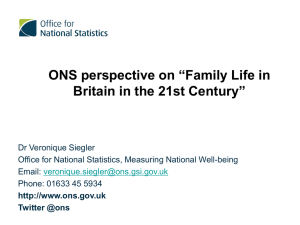

![Children`s mental health is parents` gre[...]](http://s3.studylib.net/store/data/007175392_1-8975cac3d2bf4181e48155b9fb82c0e2-300x300.png)
